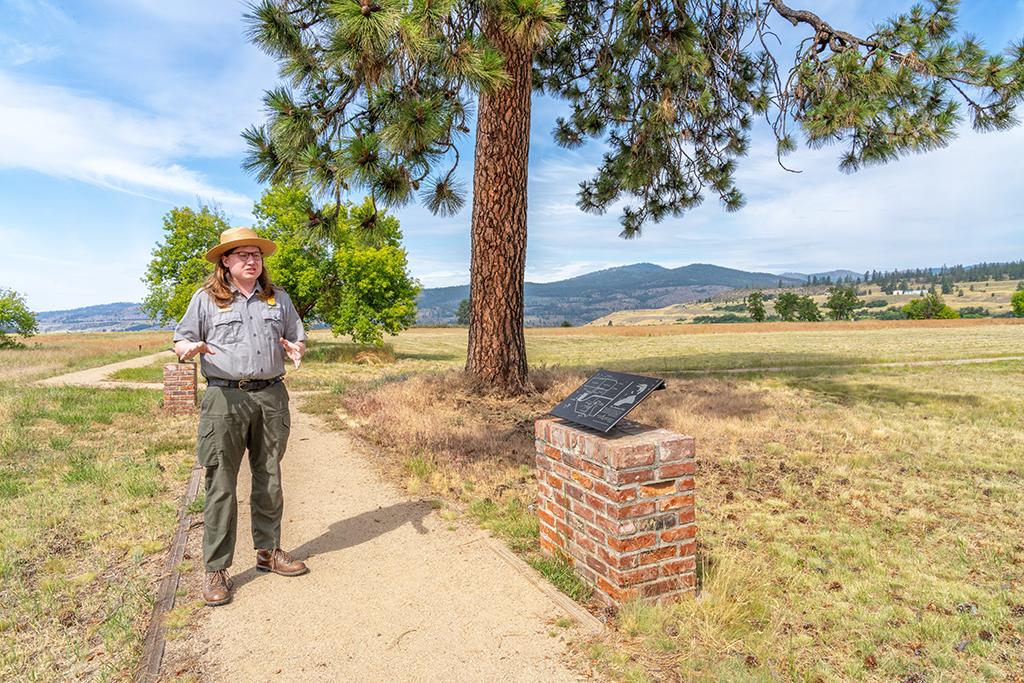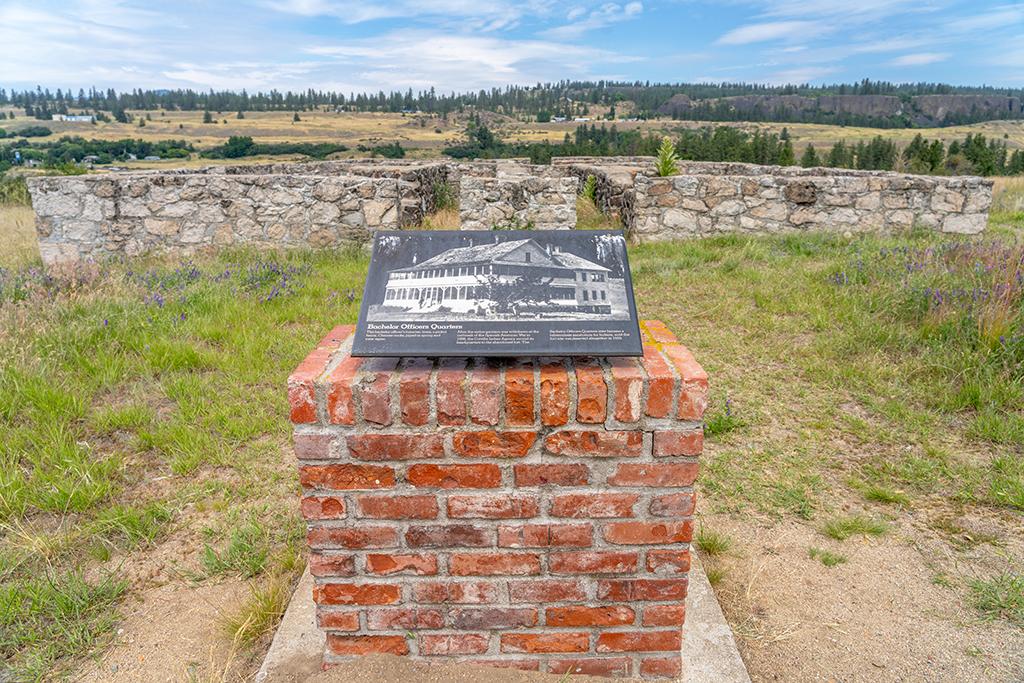
A nice day for a little boating at Lake Roosevelt National Recreation Area / Rebecca Latson
Units of the National Park System are where they are because of history, a particular subject or event, or a landform. With Lake Roosevelt National Recreation Area in Washington state, it’s all about water. If you are a boater, paddler, swimmer, or fisher, this is the perfect unit of the National Park System for you. If you don’t engage in any of those water sports very much, then maybe a little history might “float your boat” instead, because Fort Spokane, located along the southeastern border of this NRA, has the history. And, that history is all about water, too.
I don’t boat/paddle/swim/or fish very often, but I still wanted to see what this NRA was about, especially after discovering the existence of Fort Spokane. Excited about the opportunity to learn a little history while exploring a portion of this park unit, I left home early one June morning, arriving just prior to the 10 a.m. ranger-led tour of the fort grounds.

Welcome to Fort Spokane, Lake Roosevelt National Recreation Area / Rebecca Latson
One of the first things Ranger Hunter Wood told our small group of three adults and one happy little toddler is that this fort in all its iterations - military base, Indian boarding school, tuberculosis sanitarium - was there because of the water. “Water has impacted the area in so many ways: physically, culturally, geologically,” he told our group.
With water in mind, we learned a little bit about the area’s prehistory, starting around a hundred thousand years ago, when mammoths and ground sloths roamed the valleys through which wound a single river over a large open space. Water changed this scene 18,000 – 13,000 years ago, when the explosive tumult of the Ice-Aged Glacial Lake Missoula flood shot across the landscape of Montana, Idaho, Washington state, and Oregon in an unprecedented torrent, churning and gouging out soil and rocks while carving basalt ravines (coulees) hundreds of feet deep before ultimately emptying into the Pacific Ocean.
In the present day, the landscape around Fort Spokane consists of steep cliff edges and a much deeper Columbia River. The fertile silt and soils filled with nutrients and organic material have been moved by these Ice Age floodwaters further south of the NRA, all the way into the Willamette River Valley of Oregon. These fertile valleys attracted settlers who eventually made their way up to this confluence of Spokane and Columbia rivers.
Before those settlers, however, evidence of human activity as far back as 11,000 years shows the land has always been known for the tribes living along the rivers. Native peoples traveled from place to place, hunting, and gathering, always returning to the Columbia River for the annual salmon migration. Water gave life to the salmon, and salmon gave life to the tribes.
A favorite fishing place for the tribes was Kettle Falls, about an hour north of Fort Spokane. Accessing the large flat rocks of the falls with their canoes, the Spokane and Colville tribes caught an abundance of salmon with spears and nets – enough to constitute 80 percent of their diet. So much salmon was fished from the water that after Fort Spokane was established, smoked salmon was often traded to men at the military base, which in turn probably comprised a large part of the soldiers’ diet.
The water held more than just salmon. There was gold. Not much, and mainly up in the Kettle Falls area on tribal lands. Challenging situations ensued as settlers and miners ventured onto those tribal lands, fomenting disputes not only over the gold but also over salmon rights. Settlers and miners decided they liked salmon, too.
The government established the Spokane and Colville Indian reservations in 1872 and 1877, and Fort Spokane in 1880, to mitigate issues between settlers and tribes. The fort is located at the confluence of the Spokane and Columbia rivers, along which the reservations reside. Water, and what it held, necessitated the establishment of this fort.

Ranger Hunter Wood talking about life at Fort Spokane, Lake Roosevelt National Recreation Area / Rebecca Latson
With that bit of history under our belts, Ranger Wood began telling us of life on fort grounds, which, for the soldiers, was mundane and downright boring. Marches and drills on the parade grounds filled the soldiers’ days, preparing them for battles that never occurred and shots that were never fired. “Fort Spokane was not a very necessary military fort,” Ranger Wood told us. “The number one cause of death here for the military was alcoholism.” Still, this quiet fort was a good place to be stationed as opposed to forts in California or further east, where white settlers and natives often engaged in deadly clashes for land and resources.

Fort Spokane parade grounds, Lake Roosevelt National Recreation Area / Rebecca Latson
In addition to the parade grounds, there was a plum orchard, root cellar to keep vegetables cool, a blacksmith, bakery, pumphouse, guardhouse, stable for the many mules and few horses, barracks, and officers’ housing.
The enlisted men (boys, really) lived in barracks, bachelor officers in a separate dorm building, and older married officers lived with their families in small homes lining the parade ground (aka Officers Row), with views out toward the Spokane and Columbia confluence.

All that remains of the bachelor officers' housing at Fort Spokane, Lake Roosevelt National Recreation Area / Rebecca Latson
Back in the present, we walked with Ranger Wood along the perimeter of the parade grounds lined with box elder and ponderosa pine. The wooden portions of the buildings are gone, having been “repurposed” to build area homes after the fort was abandoned. Stone foundations are vestiges of the barracks, the bachelor officer’s dorm, and the small homes for the married officers. The landscape and spots between these stone foundations are given over to fescue and wheatgrass, spotted with patches of purple vetch blooms and creamy-colored yarrow. A meadowlark serenades us with a bright, cheery song, and the breeze blows across the grass, creating “ocean” waves in the prairie.
After 18 years, the Spanish-American war started and all those men “sitting pretty” up at Fort Spokane were sent to fight this war, perhaps encountering, or maybe even joining, Teddy Roosevelt and the Rough Riders. As such, the fort was abandoned with no resources to continue maintaining the military.
Giving the fort a renewed purpose, a plan was devised in 1900 to deal with the Native American “problem” – “A plan much, much, worse,” Ranger Wood intoned.
The bachelors’ dorm morphed into teachers’ housing for the Indian boarding school now established at the fort site to affect the forced assimilation of Spokane and Colville tribal children into American society. The quote for the legislature creating this and other Indian boarding schools was “Kill the Indian, save the man.”
The Spokane and Colville children were forcibly separated from their homes, families, way of life and everything familiar to them, and placed into the boarding school ostensibly to learn “service tasks.” What possessions they brought along were taken and burned, and they were given white shirts, white hats, and new names. Their native Salish language was banned and, if caught speaking that language, repeat offenders would be beaten and locked up in the individual cells of the Guardhouse (now the visitor center). The cell walls still bear writing and drawings of those cold, hungry, scared, incarcerated children.

A jail cell for an Indian child at Fort Spokane, Lake Roosevelt National Recreation Area / Rebecca Latson
After seven years, the boarding school closed and the fort became the site for a tuberculosis hospital treating the Native population. This lasted until the government abandoned the site in 1929. The National Park Service began working at Lake Roosevelt in 1941, five years before the national recreation area was established. There was a great deal of back and forth as to whether Fort Spokane was historically significant enough to warrant federal protection and be included within the NRA. Ultimately, the National Park Service officially assumed management in 1960 of what remained of the fort (a couple of brick buildings) as well as the land upon which it sat.
Now, where does water come into this history?
After the completion of Grand Coulee Dam in 1942, the reservoir behind the dam filled with water from the now-impounded Columbia River, creating the largest lake in Washington state: 130-mile-long Lake Roosevelt, named in honor of Franklin D. Roosevelt. The dam provided irrigation water for the Columbia Basin Project, electricity for the growing population of the Pacific Northwest, and the necessary power to refine plutonium for the war effort.
Problematic to the dam’s creation was the devastating impact this reservoir and impounding of the Columbia River created on the Spokane and Colville peoples by destroying the salmon’s migration route to the Pacific Ocean. While there are landlocked salmon (kokanee) in the waters above the dam, and tribal hatcheries attempting to make up the loss of a food source once constituting 80 percent of the tribes’ diet, the biggest problem is finding a way to bring home the salmon from the ocean, and back up the Columbia River beyond the Grand Coulee Dam. That would require one heck of a fish ladder. Perhaps a solution will be found with the recent funding provided by the Bipartisan Infrastructure Deal to help reintroduce salmon to the Upper Columbia.
As we returned to the visitor center, Ranger Wood and I agreed that, while the “Big P” parks such as Yosemite or Yellowstone are well known for many things, it’s these other, smaller park units and the places within these park units that surprise, educate, and entertain us with their history and subject matter. Fort Spokane is one of those places within the larger Lake Roosevelt NRA purview that educated and entertained this non-boater-paddler-swimmer-fisher (me) and perhaps it might entice you for a visit, too.
Fort Spokane offers a ranger-led tour of the grounds every Saturday in the summer at 10 a.m. at the visitor center.

Guardhouse turned Visitor Center at Fort Spokane, Lake Roosevelt National Recreation Area / Rebecca Latson
If you want to spend a night or two at this NRA, there are seven campgrounds, with Fort Spokane Campground offering 67 units (4 tent only and 1 ADA accessible site) for $23 from May 1 – September 30, and $11.50 from October 1 – April 30. There’s a 50 percent discount for valid America the Beautiful Senior or Access passholders. The campground is by reservation only through recreation.gov.

Campsites at Fort Spokane Campground, Lake Roosevelt National Recreation Area / Rebecca Latson

 Support Essential Coverage of Essential Places
Support Essential Coverage of Essential Places






